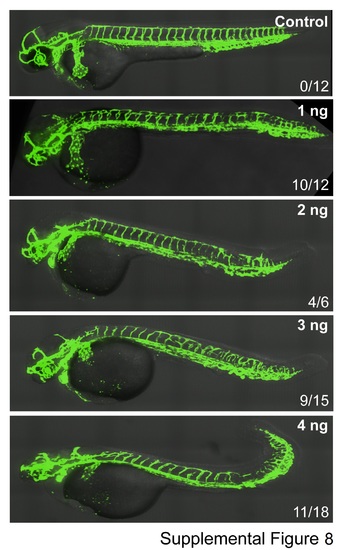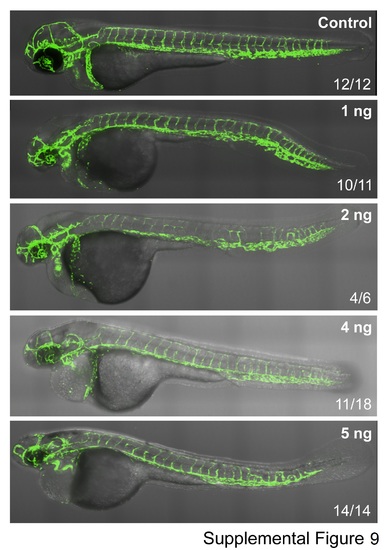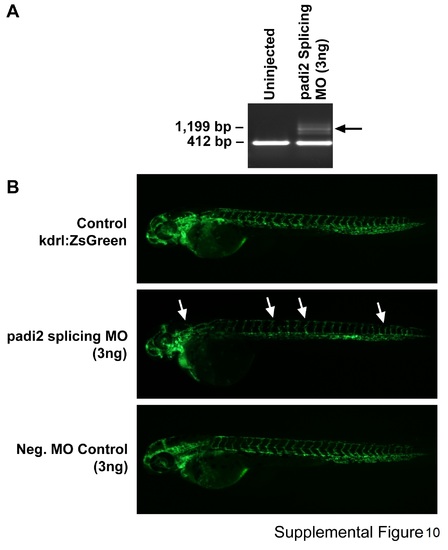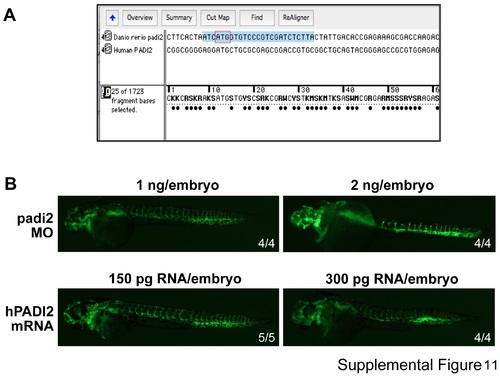- Title
-
Identification of Padi2 as a novel angiogenesis-regulating gene by genome association studies in mice
- Authors
- Khajavi, M., Zhou, Y., Birsner, A.E., Bazinet, L., Di Sant, A.R., Schiffer, A.J., Rogers, M.S., Krishnaji, S.T., Hu, B., Nguyen, V., Zon, L., D'Amato, R.J.
- Source
- Full text @ PLoS Genet.
|
padi2 morphants display vascular defects at 48 hpf. A) Significant vascular defects in padi2 MO compared to sham-injected MO (negative) control siblings (representative figures from 16 injections, repeated 4 times). Note the gaps present in the intersegmental vessels suggesting missing or abnormal formation. Also note vessel absence in the head (arrows). Magnification: x10. B) Higher magnificantion imgages showing head vascular defects in embryos injected with zebrafish padi2 MO. PHENOTYPE:
|
|
Human PADI2 mRNA can rescue vessel defects in zebrafish padi2 morphants. A) Significant vascular defects (arrows) are present in padi2 MO (1.5 ng/embryo) (b) compared to standard (sham-injected) MO control (1.5 ng/embryo) (a) and human PADI2 (hPADI2) mRNA only (225 pg/embryo) (c). Co-injection of hPADI2 mRNA (225 pg/embryo) rescues padi2 MO (1.5 ng) vascular defect. (d) Magnification: x10. B) Bar graph of normal and defective ISVs in four different groups, showing average ±SD from four independent experiments. Missing and abnormal formation of ISVs are considered as defective vessels. The number of defective vessels is significantly increased with the injection of padi2 MO (* and ** denotes P<0.001 and P<0.005 respectively.) C) Citrullination levels in zebrafish. The level of deiminated protein is partially rescued in padi2 morphants with the co-injection of hPADI2 mRNA. PHENOTYPE:
|
|
padi2 morphants display vascular defects at 48 hpf in a dose dependent manner. Gaps in the formation of intersegmental vessels (missing or abnormal pattern). Also note structural body malformation at higher doses. Magnification: x10. |
|
padi2 morphants display vascular defects at 72 hpf in a dose dependent manner. Gaps in the formation of intersegmental vessels (missing or abnormal pattern). Also note structural body malformation at higher doses. Magnification: x10. |
|
Splicing padi2 morphants display vascular defects at 48 hpf. A) RT-PCR of total RNA extracted from padi2 morphants show the newly designed MO causes an aberrant splicing resulting to partial retention of intron 6 within the transcript. B) Significant vascular defects in a new padi2 MO compared to standard-injected MO (negative) control siblings (representative figures from 12 injections, repeated 3 times). Note the gaps present in the intersegmental vessels suggesting missing or abnormal formation. PHENOTYPE:
|
|
Dosage Titrations for padi2 MO and hPADI2 mRNA injection. A) Poorly conserved region at the 5' ATG start site between zebrafish padi2 and human PADI2 mRNA sequence. The designed MO targets the ATG start site (highlighted) of zebrafish padi2. MOs differ by more than five out of 25 nucleotides from their target sequence do not interfere with translation of the targeted mRNA. B) By titrating the dose of human PADI2 (hPADI2) mRNA, we determined that injection of up to 225 pg into early embryos did not cause any phenotypic changes or lethality. Notably, injection of high copy number of hPADI2 mRNA (>250 pg) alone results in significant toxicity in zebrafish. |




